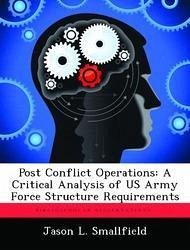The study concludes that US Army force structure is inconsistent with US strategic policies, is not based upon nor informed by practical lessons of the past, and does not strike a balance among the suite of capabilities necessary to conduct full spectrum operations. Numerous steps must be taken in order to give the US Army the capability to adequately conduct post conflict operations and therefore achieve and sustain national policy objectives. Although joint doctrine addresses post conflict operations, it does not offer the clarity needed concerning operational terminology. Post conflict operations terms must be clarified and defined at the joint level. After addressing the challenges within joint doctrine, the Army should reexamine those requisite PCO decision support mechanisms. Finally, reorganizing the US Army 's force structure provides the required capabilities to bridge the gap between military led combat operations and civilian led nation building operations. This reorganization must rebalance forces among the active, guard, and reserve structures and create a post conflict joint command organization. These steps will help to ensure that the US Army is able to not only win our nation 's wars but also to win the peace following those wars.








